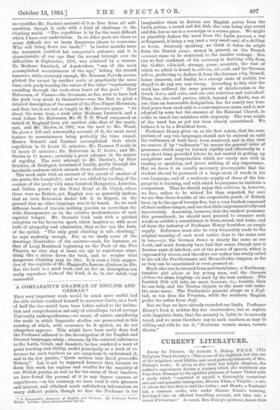CURRENT LITERATURE.
Among the Tibetans. By Isabella L. Bishop, F'.R.G.S. (The Religious Tract Society.)—This is one of the slightest, but also one of the brightest, most lifelike, and most perfectly balanced, of Mrs. Bishop's works. It gives, in five brief but bright chapters, the author's experiences during a journey which she undertook one Juno from Srinagar to the uplifted plateaux of Lesser Thibet with a party which "consisted of myself, a thoroughly competent servant and passable interpreter, Hassan Khan, a Panjabi ; a setts, of whom the less that is said the better ; and Mande, a Kashmiri lad, a common coolie, who under Hassan Khan's training, developed into an efficient travelling servant, and later into a smart Khitmatgar." As usual, Mrs. Bishop's pictures, drawn from
the life, are temptingly quotable, and did space allow, we should reproduce several of them, because, better than anything in the way of criticism, they indicate the character of the book. Even with present limitations, we must give this vivid passage :— " Not greater is the contrast between the grassy slopes and deodar-clothed mountains of Kashmir and the flaming aridity of Lesser Thibet, than between the tall, dark, handsome natives of the one with their statuesque and shrinking women, and the ugly, short, squat, yellow-skinned, flat-nosed, oblique-eyed, uncouth- looking people of the other. The Kashmiris are false, cringing, and suspicious ; the Thibetans truthful, independent, and friendly, one of the pleasantest of peoples. I ' took to them at once at Shergol, and terribly faulty though their morals are in some respects, I found no reason to change my good opinion of them in the succeeding four months." Or take the delightful and characteristic description of Unman Shah, who was sent to meet Mrs. Bishop when She entered Kashmir 1—" He wore a turban of prodigious height, ornamented with poppies and birds' feathers, loved fantastic colours and ceaseless change of raiment, walked in front of me carrying a big sword over his shoulder, plundered and beat the people, terrified the women, and was eventually recognised at Leh as a murderer, and as great a ruffian in reality as in appearance." Those who are familiar with Mrs. Bishop's books are also aware that she is above all things a realist; but we cannot help wondering if it is realism or humour that makes her say of one of the deities represented on a chod-ten or relic- holder, that it "has a striking resemblance to Mr. Gladstone." When Mrs. Bishop describes her adventures—including, by the way, one in which she almost lost her life—she gives to her narrative a picturesque vividness which is unsurpassed by any living writer of travel. Of course, her journeys in the present book are over tolerably familiar ground, but it can be at least said that she makes "wonders from the familiar start." When she comes to deal with the manners and customs of the Thibetans, she acknowledges her obligations to Mr. Redslob, a Moravian missionary, whose premature death seems to have been a great blow to Thibetan scholarship, and who appears to have been in a very real sense the " father " of his " people." Mrs. Bishop bears the very highest testimony to the good which has been done by the preachers of Christianity, especially by "those noble German missionaries, learned, genial, cultured, radiant, who, whether teaching, preaching, farming, gardening, printing, or doctoring, are always and everywhere living epistles of Christ, known and read of all men." Christian missions have made Mahommedanism militant in Africa ; they seem to have had the same effect upon Buddhism in Thibet. "The abbot of the Kylang monastery lately said to Mr. Heyde,' Your Christian teaching has given Buddhism a resurrection.' The actual words used were, ' When you came here, people were quite indifferent about their religion, but since it has been attacked, they have become jealous, and now they know." On the whole, and while there can be no question that Mrs. Bishop has produced a fascinating book, it is doubtful whether climatic considerations will allow many of her readers to follow her. Whowould care to spend even forty-eight hours at Lachalang ? There Mrs. Bishop noted a solar temperature of 162°, only 35° below the boiling-point of water in the same region. To atone for this, the mercury falls below the freezing-point every night of the year; thus the difference of temperature in twelve hours often exceeds 120°.



















































 Previous page
Previous page